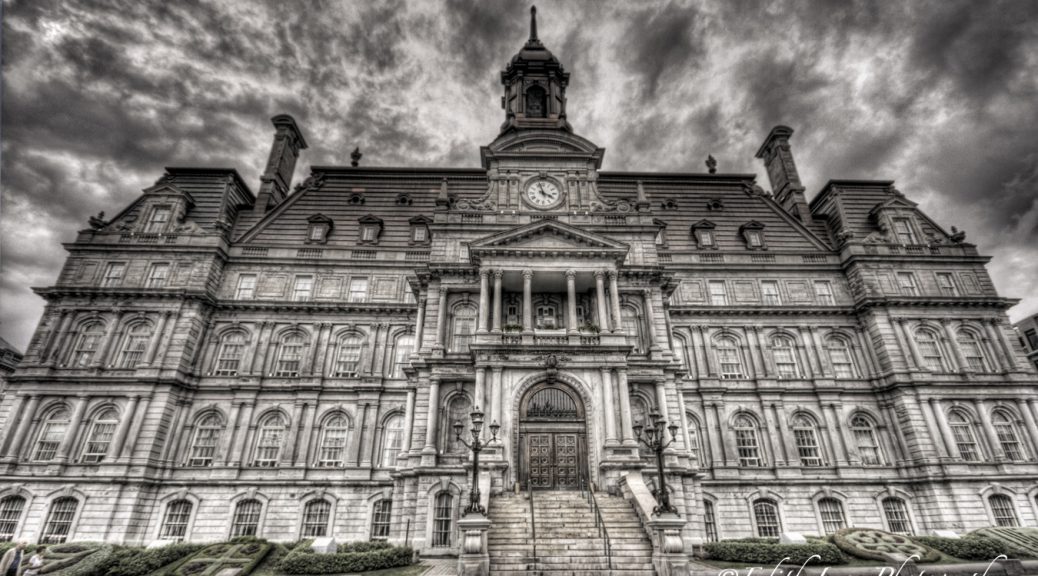 [The following is a point-form note series on Local Government Politics aggregated from an academic course on that subject.]
[The following is a point-form note series on Local Government Politics aggregated from an academic course on that subject.]
City sidewalk, safety and Jane Jacobs:
– Sidewalks are more than just for carrying pedestrians from place to place
– Uses bound up with circulation but not identical to it
– In itself it is nothing, only in conjunction with the buildings and other uses that border it, or border other sidewalks near it does it mean something, same thing for streets
– Both vital organs for the city, it identifies the type of city,
i. Safe streets = safe city
ii. Jungle = sidewalks make people feel unsafe
– The users of sidewalks are active participants
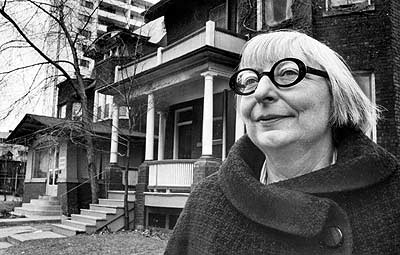 – To keep cities safe, streets and sidewalks are fundamental to that task
– To keep cities safe, streets and sidewalks are fundamental to that task
– Different in cities than in suburbs and small towns because the city is full of strangers
– When people don’t feel safe they use them less and the corollary is less safety
– Not just a problem in slums or older parts of a city
– Areas where rebuilding done suffer from the problem a lot
– Public peace not necessarily kept by police, primarily by an intricate almost unconscious network of voluntary controls and standards among the people themselves
– Can’t stop crime by spreading people out more thinly, ex: LA almost all suburban but high crime
– Some afford the ability for street barbarism. Ex: North end of Boston assaults stopped by people in the streets and onlookers from buildings, in suburban Roxbury area of Boston, urged people to stay off the streets, more violence
– A street equipped to handle strangers and to make it a safety asset of itself, out of the presence of strangers have three qualities:
i. Clear demarcation between public and private space
ii. Eyes on the streets
iii. Continuous users à induces people to build along the streets creating more eyes
– Surveillance/mutual unimposing surveillance needs stores and other public places along the sidewalks, helps in several ways:
i. Gives concrete reasons for using the sidewalk
ii. Draw people along the sidewalks past place which have no attraction as public space
iii. Store owners and businessmen are typically proponents of peace and order
iv. Sight of people attracts others
– Strangers are an asset. In opposition to the policy of putting up more lights, they don’t help unless people are there
– Goal of safety is so that everyone can feel safe everywhere not only in specific areas, if not it can lead to turfs
– Certain people not allowed in certain spaces
– Example of high rise building facing away from street in Jacobs’ neighborhood, people tend to be interested in their own lives, if other events are not in their face
– Multipurpose streets, Bars, Shops, etc. activity all the time
[The following is a point-form note series on Local Government Politics aggregated from an academic course on that subject.]
“Robbing the bank as a career”:
– Referencing the David Grann New Yorker piece, “The Old Man and the Gun”
- Forrest Tucker, member of the infamous “over the hill gang” famous for all being elderly bank robbers, highly successful
- Spent his life in and out of Jail
- Even at the age of 79 with substantial assets and an affluent house in a relatively prestigious community in Florida decided to rob one more bank
- Illustrates that crime is appealing for some innate reason for some, however qualified by the fact that early on in his life, because of his socio-economic status, he was all but forced into a life of crime, he was unable to find opportunities to succeed in his preferred career as a musician
- As well the discretion of police authorities and the judicial system was present, if he was given a more lenient sentence early on he may have never developed his criminal mind and skills while in the detention center and prisons.
-
 “Nation of cowards”:
“Nation of cowards”: - Title of Jeffrey Snyder’s article discussing the gun control policies in North America, slightly touches on Canada but primarily focuses on the US and the second amendment right “The right to Bear Arms”.
- Tension between individuality and incalculable self-esteem vs. reverting to being a victim – let the criminal do what he wants
- Crime is a complete disavowal of the social contract but also a commandeering of the victim’s person and liberty
- It violates a victims dignity, if not fighting for your dignity, maybe then it doesn’t exist
- Crime is rampant because the law-abiding condone it, not because of failures of the judicial/penal system, the defect is in our character
- More likely to be a victim of a violent crime than in a car accident, people believe the existence of police will protect them and relieve them of their responsibility to protect themselves, the police are general deterrents not personnel bodyguards (of all violent crimes (1991) only 28% of calls were responded to within 5 min. or less)
- Protection is not a service that can be effectively delivered by the police
- Police do not even have the legal responsibility to protect individuals
- How to protect than, buy a gun
- But laws against carrying firearms (Great American Gun War)
- Gun control is the battleground, the fight for gun rights done by the common man, the fight against them, for restrictions are levied by elite
- Gun control measures as effective crime prevention are unknown, did not prevent John Hinckley Junior from attempted assassination of Ronald Reagan
- Gun control tends to blame law abiding gun owners, however, 90% of the violent crimes are committed with out hand guns, and 93% of guns obtained by violent criminals are not obtained legally
- Gun control restricts law abiding citizens and is thus ineffectual
- False stereotypes of gun owners – stats show more likely to be educated, more likely to have prestigious jobs
- Florida experience – law allowing concealed fire arms, homicide rate actually fell (casual mechanism not verified)
- Possession of arms are vital for resisting tyranny (Machievelli, Hobbes), vital so that the government will govern only with the consent of the governed
- Should trust law abiding citizens
[The following is a point-form note series on Local Government Politics aggregated from an academic course on that subject.]
 Empowered deliberative democracy:
Empowered deliberative democracy:
-
Illustrated within the pages of the Anchor Fung article “Accountable Autonomy: Toward Empowered Deliberation in Chicago Schools and Policing”
-
Empowered deliberative democracy refers to the ability of citizens being directly involved in the decision making process, specifically in the case of the Fung article the policies associated with the education and policing in Chicago
-
The expectations that citizens’ participation and deliberation will palpably and directly affect public action and its results. Ordinary channels of political influence and public discussion are less empowered on both of these dimensions. When one participates in deliberation in the public sphere of mass media as a spectator or even as an author, votes for a candidate to represent ones views, or serves on advisory committees, there is but a thin connection between one’s views and official actions. The Chicago reform increase citizen power over public affairs on at least two dimensions:
-
Citizens join with street level public official s such as teachers, principals and police officers, to analyze localized problems and develop plans of response.
-
Even if not incorporated into interim plans they will at least have been publicly considered against other proposals.
-
Evidence shows that there has been negligible amounts of corruption, however no observer could sustain that any instance was totally deliberative and absent of any domination.
-
Examples of Traxton and Central Elementary showed that for the process to be effective it has to be supervised by a central authority, but not with the traditional heavy-handed authority but with an eye towards collaboration.
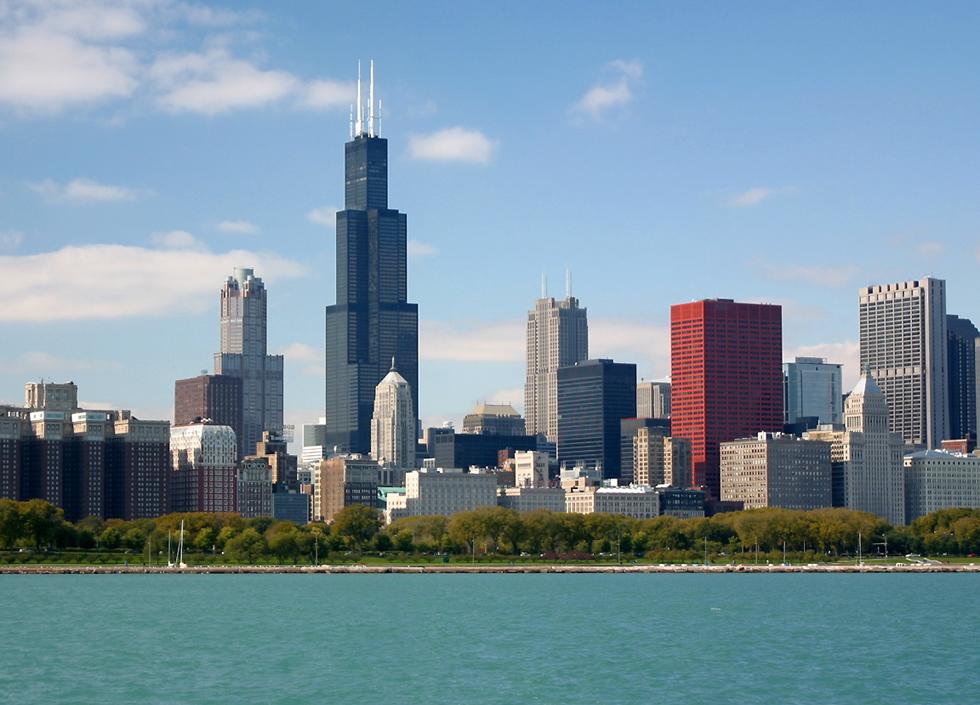 CAPS:
CAPS:
“Chicago Alternative Policing Strategy”, the strategy that the Chicago Police Department adopted in its recent organizational reforms.
-
At the end of the 1980s, police forces and chiefs in many US cities were engaged in self-reflective doubt about whether their two traditional methods – preventative patrols that demonstrate presence through marked vehicles and rapid response to 911 calls for emergency service- could address the diverse and sever crime and disorder they faced.
-
Similar to the educational reforms
-
Reforms were under broad rubric of “community policing” and called for officers to use their initiative and ingenuity to tackle particular problems of crime and disorder and for theme to move closer, sometimes to build partnerships with, citizens whom they served.
-
Two forces encouraged these reforms: Leaders from a sophisticated city wide public safety organization called the Chicago Alliance for Neighborhood Safety (CANS) and the office of Chicago Mayor Richard M. Daley
-
An example of Accountable Autonomy and Empowered Deliberation. Created three central planks of participatory local autonomy in police governance: The reforms created opportunities for ordinary citizens to participate continuously and directly in the microgoverrnance of the institutions Participation under this devolution instituted deliberative decision procedures.Empowerment, the expectations that citizen’s participation and deliberation will probably and directly affect public action and its results.
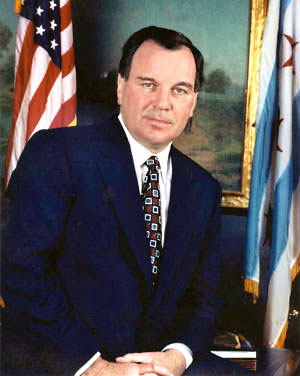 CANS: -Chicago Alliance for Neighborhood Safety (CANS),
CANS: -Chicago Alliance for Neighborhood Safety (CANS),
-
Had used their policy expertise to advance a community-centered vision of community policing. From CANS’s perspective, based upon its experience as advocate, police policy analyst, watchdog, and neighborhood organizing entity, other cities had largely excluded citizens form their reforms, and so they amounted more to policing of the community that in partnership with it.
-
CANS activists thought that citizens ought to be full partners in community policing because they could provide important local knowledge, distinctive resources and could monitor police officers and hold them accountable.
-
Was one of the two forces that encouraged the CPD to adopt a more community based policing policy, the other being Mayor Richard M. Daley.
-
Demonstrated citizen involvement in making changes in local government which eventually led to the Accountable autonomy and deliberative democracy present in contemporary CPD.
[The following is a point-form note series on Local Government Politics aggregated from an academic course on that subject.]
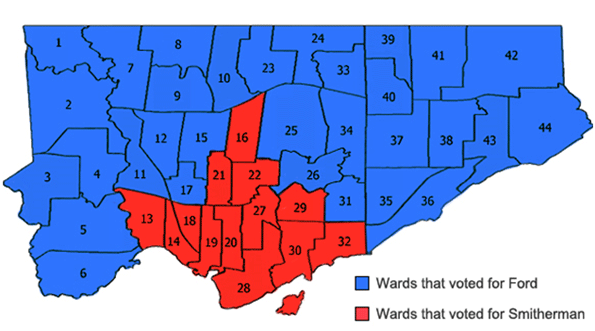 The Toronto Amalgamation: – Referenced in multiple readings:
The Toronto Amalgamation: – Referenced in multiple readings:
- Toronto’s legal Challenge to Amalgamation (Beth Moore Milroy)
- Signs of Life? The transformation of two tier metropolitan government (Sancton)
- How Big should govt’s be (Sancton, Sewell, Rusk, Martin)
- Amalgamation has not necessarily raised the quality of service or been effective in reducing costs
- Amalgamation has wiped out a lot of the links between people and their local governments
- Some services have economy of scales and benefit from having larger organizations provide them.
- Some have diseconomies of scale,
- Hard to measure quality of services
- Massive bureaucracy constantly in turmoil slows things down
- Amalgamation of 6 cities, elimination of regional govt (Metro)
- Amalgamation ended cost sharing arrangements and citizenry’s expectations about their capacity to influence the city’s evolution
- Torontonians realized their rights to shape their city as citizens were highly circumscribed
- Canada citizens rights reside in country and provincial level not the city
- Contrast to midlevel communes
- City of Toronto act, 1997 Bill 103
- Process began in 1988
- Goal economic benefits for province, nothing to do with citizens desires, gave the 6 mayors 30 days for an alternative, oct 1996, not enough time
- 5/6 mayors opposed on first reading dec. 1996
- Citizen groups opposed, brought to court on 4 premises:
- Convention of prov/municipal relations that lend to reasonable autonomy
- Provincial legislation in this case will create harm to individuals as interpreted by charter
- Province using power in cavalier manner
- Using utilitarian calculations to justify but logic nor evidence supported those claims
- The case of Toronto’s Amalgamation starkly shows the effects of a constitutional and legal regime in which cities are tools o more senior governments to be used in their service delivery, fiscal, and economic interests without an equally strong counterweight in local citizenship rights. Balance is missing. Here is where citizens need to apply pressure for change
 Gypsy Cabs: – Referenced in F. Ianni “Gypsy Cabs: Organized Crime or Minority Business Enterprise” The Black Mafia
Gypsy Cabs: – Referenced in F. Ianni “Gypsy Cabs: Organized Crime or Minority Business Enterprise” The Black Mafia
- A burgeoning new venture into minority entrepreneurship that has been developing in a number of American cities over the past decade. Usually called gypsy cabs
- It involves the use of automobiles for hire as taxis despite the fact that they do not meet the legal standards and conditions for taxicabs.
- Through the use of a variety of semi and openly illegal practices, the gypsies operate in ghetto areas where legally licensed taxis seldom venture
- Despite being illegal many cities tacitly accept it and allow it to develop otherwise heavy criticism would be drawn related to the unequal service and treatment that ghetto, minority inhabited areas are provided by the “yellow” cabs (i.e. NYC)
- Also related to the fact that NYC has a limited amount of Medallions (Haas Act) approx. 12000 medallions available
- Examples where it led to rampant illegality – The super fast cab company & The black diamond special omnibus insurance company
- Underlying cause – desire for middle class way of life.
[The following is a point-form note series on Local Government Politics aggregated from an academic course on that subject.]
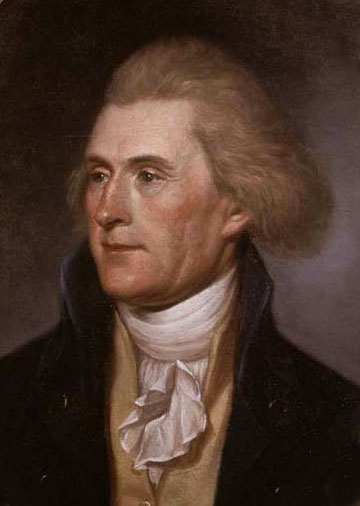 Jefferson’s Ward Republic System:
Jefferson’s Ward Republic System:
– Found in “The structure of American local Government” Brian P. Janiskee
- Jefferson considered the creation of a ward republic system of local government one of the two most important elements upon which the future of the republic depended, the other being the creation of a public education system. Jefferson devised a four-tiered system that would comprise national, state, county, and ward levels. Each county would be divided into checker-box wards of about 25 square miles, large enough to ensure an appropriate level of support for vital local functions, yet small enough to allow for regular direct participation. Jefferson’s goal was to encourage citizens to be active members of their government. In this way, the revolutionary spirit of the regime would survive the potentially ossifying characteristics of an established constitutional government.
- Hannah Arendt claims that the ward system, although never implemented, was Jefferson’s most cherished political idea.
- The ward system would institutionalize the revolution. It simultaneously would check the tyrannical tendencies of the central government and the enervating tendencies of private local life. Such dangers include a private debasement of virtues into the selfishly commercial, devoid of politics and filled with corruption
- Reveals Jefferson’ politics of continual revolution
- The ward system would mitigate against the violence associated with revolution
- System not developed because of a penchant for geographical neatness
- Jefferson thought that a system of local government containing geographical concise units was central to the survival of the republic
- Focus on grass roots government
- Related to structured polycentrism
- Beyond polycentric and mono-centric, many units of government with autonomy, so citizens can gain meaningful attachment to government
- Polycentiricism: local fragmentation is beneficial, instead of forcing hierarchical structures form above, rely on local autonomy
- Monocentrisits: single community requires single government, regional government would provide better economies of scale therefore more efficient
 The City of Vancouver’s Recent Corporate Initiatives:
The City of Vancouver’s Recent Corporate Initiatives:
– Referenced in Urban Governance in Canada by K. Graham, S. Phillips with A. Maslow
- The city of Vancouver is like most government organization; Process rather than results control too much City work. Many of the systems are slow, complex and over controlled. Plus over expenditures, need for change (1994 statement)
- The city’s prescription for dealing with these has involved both structural and attitudinal change. Some highlights of Vancouver’s recent corporate initiatives are as follows:
- Reduction in the number of city departments from 18 – 10. Internal administrative functions have been clustered into a new corporate services dept.
- Elimination of some senior management positions, including the deputy city manager, the director of Economic Development.
- Creation of a new civic management team, which consists of the city manager, key department heads, and the administrative heads of the city’s major agencies, boards and commissions (police chief, head of parks)
- A corporate commitment to re-orienting the operating style of the city. The Key phrases in this context are delegation; decentralization; customer consultation; teams; interdepartmental consultation; service standards and monitoring, flexibility; and empowerment of managers to coach, mentor, and support staff rather than control
- New openness to alternative service models including technology based services; enhanced use of volunteers; regulated privatization of traditional municipal functions, such as handling of building permits, new emphasis on partnerships and joint delivery and contract servicesThe formal proposal for the city’s new corporate direction distances itself from the general trend among governments to downsize: “Our objectives is not to downsize but to make us more effective
- -Corporate downsizing through the reduction of departments
- Achievement of financial efficiencies though re-engineering some of the city’s work process has also been part of the plan.
 [The following is a point-form note series on Local Government Politics aggregated from an academic course on that subject.]
[The following is a point-form note series on Local Government Politics aggregated from an academic course on that subject.]
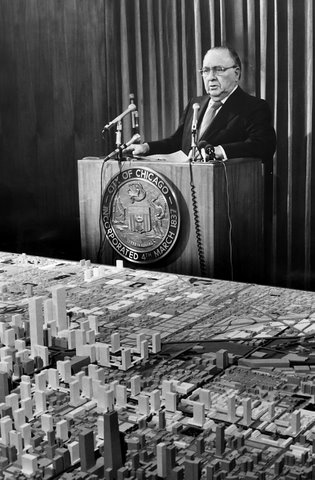 Richard J. Daley:
Richard J. Daley:
– Introduced in the A. Ehrenhalt chapter excerpt from the Lost City
- Quintessential boss rule Mayor (Chicago)
- Daley’s ways may not have been democratic, but his defenders have argued that he got positive things done for Chicago which a non-boss would have been unable to do.
- Their eldest son, Richard M. Daley, was elected mayor of Chicago in 1989, and has served in that position ever since. The youngest son, William M. Daley, served as US Secretary of Commerce from 1997-2000. Another son, John Daley, is a member of the Cook County Board of Commissioners.
- Major construction during his terms in office resulted in O’Hare International Airport, the Sears Tower, McCormick Place, the University of Illinois, Chicago campus, and other major Chicago landmarks. O’Hare was a particular point of pride, with Daley and his staff regularly devising occasions to celebrate its “opening.”
- John Fary was a loyal servant to the Daley Boss rule, used as an example of the order and rules followed at the time, less choice/freedom, but effective
- Manipulated media and local oppostion forces by cleaning up certain areas of corruption, for example the seeling of drivewayy permits to homeowners for whatever price the homeowner was willing to pay under the table
- Sinner but effective in countradistinctio to Martin Kennelly who was an ineffective saint
- Slavish loyalty to obedience was essential
- Richard Joseph Daley (May 15, 1902 – December 20, 1976) was an Irish-American politician who served as Chairman of the Cook County Democratic Central Committee from 1953 and Mayor of Chicago from 1955, retaining both positions until his death in 1976. He is also known as “Old Man Daley,” “Daley Senior” to residents of Chicago.
- Daley was Chicago’s third mayor in a row from the heavily Irish Bridgeport neighborhood. He served in that position longer than any other person. According to Chicago folksinger Steve Goodman, no man “could inspire more love, more hate.”
- First elected in 1955, he served six terms as mayor. Known for shrewd party politics, Daley was the prototypical “machine” politician, and his Chicago Democratic Machine, based on control of thousands of patronage positions, has been considered by some to have been instrumental in helping to elect John F. Kennedy in 1960.
- It was often alleged that his administration used questionable tactics to acquire votes, with the ironic phrase “vote early and vote often” frequently used to describe to his method of delivering votes.
- Daley’s chief electoral method was his reliance on the local precinct captain, who marshaled and delivered votes on a neighborhood-by-neighborhood basis. Many of these precinct captains held patronage jobs with the city, mostly minor posts at low pay. Each ward had a ward leader in charge of the precinct captains, some of whom were corrupt. A few wards were tied to the local mafia or crime syndicate.
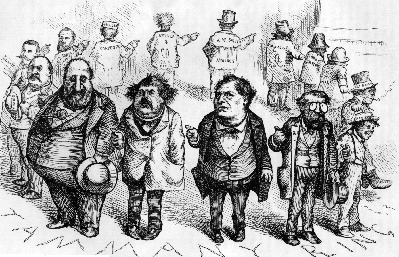 Boss Rule, Machine Politics and Utility Enterprises:
Boss Rule, Machine Politics and Utility Enterprises:
– Referenced in the chapter Excerpt from V. Ostrom, R. Bishe & E. Ostrom “The Struggle for Local Self Government”
- William M. Tweed was the New York City’s political boss. His headquarters, located on East 14th Street, was known as Tammany Hall. He wore a diamond, orchestrated elections, controlled the city’s mayor, and rewarded political supporters. His primary source of funds came from the bribes and kickbacks that he demanded in exchange of city contracts.
- Boss-rule, machine politics, payoff and graft, and the spoils system outraged late nineteenth century reformers. But were bosses and political machines as corrupt as their critics charged?
- Many machines professionalized urban police forces and instituted the first housing regulations. Political also bosses served the welfare needs of immigrants. They offered jobs, food, fuel, and clothing to the new immigrants and the destitute poor. Political machines also served as a ladder of social mobility for ethnic groups blocked from other means of rising in society.
- In The Shame of the Cities, the muckraking journalist Lincoln Steffens argued that it greedy businessmen who kept the political machines functioning. It was their hunger for government contracts, franchises, charters, and special privileges, he believed, that corrupted urban politics.
- A radical transformation occurred in American society, industrial applications of new technologies brought new sources of energy, new services. Transformed system of government, primarily in the local and state levels
Three elements led to Boss rule:
- Population size led to changes in political organization
- Essential role of political decisions ion the variety of utility enterprises including railways, etc.
- Reliance upon a theory of the single sovereign in construing the authority of state legislatures with reference to local government
- In the south Machine politics and boss rule was perpetuated as well by the fear of African American participation, and gaining effective power.
- Immigrant communities would be heavily targeted by hopeful “bosses” they would recruit leaders in the respective minority communities and convince them that they would be beneficial to their needs through kickback and deals in the future
- Utility enterprises depended upon the granting of franchises to use public rights of way, an extension of the power of eminent domain, or both. The power of eminent domain is the power of a government to acquire property by forced sale upon compensation for fair market value, this can be extended to public utilities, creating natural monopolies
- Plus these industries would have to use public property such as pipelines.
- Used as bargaining chips for political support.
[The following is a point-form note series on Local Government Politics aggregated from an academic course on that subject.]
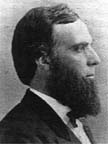 The Dillon’s Rule:
The Dillon’s Rule:
– Referenced in the chapter Excerpt from V. Ostrom, R. Bishe & E. Ostrom “The Struggle for Local Self Government”
- Hundreds of U.S. court decisions to the present day have employed the Dillon Rule to determine the scope of municipal powers and rights. Critics of the Rule have argued that it imposes unreasonable constraints on the ability of communities to govern themselves and so undermines democracy, and even that local self-government is a matter of natural right that does not need to be conferred by higher political structures. It has also been suggested that Dillon’s approach derived from the contemporary view that cities were inherently corrupt political organs. This was perhaps an often well-deserved judgment during his time, especially considering the extensive business ties and even investments of numerous cities and their leaders in the late 19th century. Deviations from the Dillon Rule remain in the minority, however, despite the significant decrease in the public perception of municipal corruption.
- – While on the federal bench, Dillon wrote Municipal Corporations (1872), which was one of the earliest treatises to systematically study the subject. Dillon explained that in contrast to the powers of states, which are unlimited but for express restrictions under the state or federal constitution, municipalities only have the powers that are expressly granted to them. His formulation of the scope of municipal power came to be known as the “Dillon Rule,” which states that municipal governments only have the powers that are expressly granted to them by the state legislature, those that are necessarily implied from that grant of power, and those that are essential and indispensable to the municipality’s existence and functioning. Any ambiguities in the legislative grant of power should be resolved against the municipality so that its powers are narrowly construed. However, when the state has not specifically directed the method by which the municipality may implement its granted power, the municipality has the discretion to choose the method so long as its choice is reasonable.
- The doctrine of inherent right of lovcal self government was rejected until it could be subsequently formulated as a legal prinicile embodied in state constitution and hence beyond the exclusive controls of the legislatures
- The acceptance of Dillon’s rule coincided with the erecetion of large-scale public utility enterprises and the development of machine politics and boss rule. Absolute and unlimited sovereignty on the part of state legislatures over municipal governments made state legislatures the focus of attention in controlling local governments. Rather than providind general rules that applied to general catergories of local government, state legislatures under this authority enacted special charters and laws that applied specifically designated cities. Such chraters enacted became instruments for detailed legislative interference in local affraids.
- Special legislation enacted by state legislatures went so far as mandating the payment of claims to designated individuals
- Dillon’s rule made legal the rape of cities by the so-calle “robber barons” of the late 19th century.
- The response of the progressive reform movement slowly eroded the Dillon rule and strengthened local autonomy.
 Human resources management in Canadian cities:
Human resources management in Canadian cities:
– Referenced in Urban Governance in Canada by K. Graham, S. Phillips with A. Masolow
- Uses examples of Winnipeg, Vancouver and Halifax to illustrate the importance of human resource management in the operations of Canadian urban governments.
- We see cities preoccupied with managing the downsizing of staff, training and motivating remaining staff, and dealing with pressure on the municipal compensation system resulting from reorganization and amalgamation or from decreasing financial flexibility
- Historically Canada exhibits two contradictory methods in dealing with human resources:
- Collective bargaining, view them as private actors therefore have a right to collective bargaining, not very sophisticated, although it needed to be
- Recent years, given it more importance, more sophisticated dealings, an increase in the professionalization and downsizing, responsibility for human resource planning
- At local level there is absence of oversight in local human resource management whereas at the federal and provincial level there is.
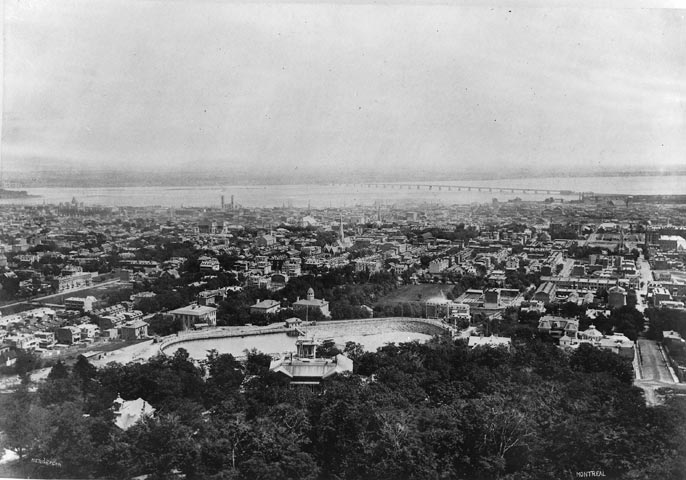 ‘Home rule”:
‘Home rule”:
– Referenced in the chapter Excerpt from V. Ostrom, R. Bishe & E. Ostrom “The Struggle for Local Self Government”
- A companion set of constitutional provisions provided a commensurate increase in opportunities for local communities to control their own local affairs subject to the general laws of the state. In more than half of the American sates, constitutional authority was extended to local communities to allow then formulating their own local municipal charters.
- Under these “hone rile” charters, citizens could stipulate their own constitutional terms and conditions of governance, and such charters could be revised or amended locally through the process initiative and referendum.
- The progressive Reform movement thus extended toe principle of federalism that had applied to the organization of the national and state governments downward so that this principle also applied to state and local units of governments as well.
- In effect, recognized a constitutional right of local self-government. Judge Cooley’s (Michigan) (Law school named after him) doctrine, in effect, became a part of several state constitutions and became to prevail over Dillon’s rule in those states.
[The following is a point-form note series on Local Government Politics aggregated from an academic course on that subject.]
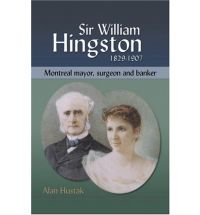 Sir William Hingston:
Sir William Hingston:
- Sir William Hingston was one of Canada’s most illustrious surgeons in the second half of the 19th century. Not only was he a very innovative surgeon but also he was an excellent teacher and wrote many medical articles during a career that spanned over 50 years. Active as he was medically, he found time to serve a term as mayor of Montreal and was on the board of directors of various banks and companies. As recognition of his many talents, Queen Victoria knighted him in 1895. He died in 1907 at the age of 78 years.
- – William Hales Hingston was born in Huntington, Lower Canada, in 1829. After his primary education, which he received in Huntington, he entered the Sulpician College in Montreal. He obtained his MD degree from McGill University in 1851 and his LRCS from Edinburgh in 1852. Further postgraduate education was followed by a year spent attending clinics and lectures in famous medical centres, including Dublin, London, Paris, Berlin, Heidelberg and Vienna. (This was a common way to obtain more experience than McGill could offer, and for English-speaking students Edinburgh was often the choice at that time.) Dr. Hingston returned to Montreal, where in 1853 he was named to the staff of St. Patrick’s Hospital. This hospital was actually on the grounds of and associated with the Hôtel Dieu Hospital. When St. Patrick’s Hospital burned down in a fire, he was accepted onto the staff of the Hôtel Dieu.
- – n the Montreal smallpox epidemic of 1885, during which over 3000 of the 157 000 population died of the disease, Dr. Hingston was chairman of the newly formed provincial board of health. Besides setting up smallpox “hospitals” and trying to improve the city’s sanitation and decrease the spread of the disease, he was instrumental in instituting compulsory vaccination, using a special police force to drag unwilling citizens to be vaccinated.[11]
- Hingston was elected mayor of Montreal for the term 1875/76. His inaugural speech on Mar. 8, 1875, concerned the public health of the city. He pointed out that the death rate in the city was between 35 and 42 per 1000 inhabitants. This was higher than any other large city in North America. He described the poor housing and sanitation of the lower classes and said that he would try to bring about an improvement in the sanitary conditions of the city and the health of its inhabitants. The problem of smallpox was discussed. Many francophone writers and the clergy of the Roman Catholic Church were against vaccination, and this showed up dramatically in the statistics. Of the 981 cases of death caused by smallpox the year before in Montreal, 953 of the patients were Roman Catholic. Only 27 Protestant anglophones died, because they were vaccinated almost without exception. (The population at that time was about 50% of each group.) Hingston also berated the city for its lack of planning (e.g., construction and housing) and vowed to improve this.
- One of Hingston’s lasting benefits to the city was the park on Mount Royal. He started the project by arranging for the city to expropriate the farms that extended onto the mountain and persuaded the city to hire Frederic Law Olmstead to come to Montreal to plan the park. (Olmstead was a famous US landscape architect who in his lifetime designed such parks as Central Park in New York, Prospect Park in Brooklyn, the area around Niagara Falls and the Chicago World Exposition of 1893.) It was he who told the Montreal city authorities to leave the mountain in its natural state rather than build amusement areas or buildings on it.
- The winter of Hingston’s term of office was a bad one for Montreal because of a recession. One day a crowd marched down to city hall to demand bread. The deputy mayor was getting ready to read the Riot Act to them. (This would allow the police to arrest the marchers or to fire upon them.) Hingston arrived on the scene, threw away the Riot Act and spoke to the crowd. He told them that it was not their fault that no jobs were available and promised to help them. The crowd dispersed, except for a hundred or so who wanted to accompany him home to prevent him from being harmed. He declined their offer and drove off alone. True to his word, he got the city to hire extra men at 65 cents a day or $1.25 if they provided a horse. They were put to work in preparing the park on Mount Royal according to Olmstead’s plans.[12]
[The following is a point-form note series on Local Government Politics aggregated from an academic course on that subject.]
 Beth Moore Milroy:
Beth Moore Milroy:
– Author of “Toronto’s Legal Challenge to Amalgamation”
- Asks the question, what rights to citizens have to shape their city, this in the face of the Toronto Amalgamation;
- The Toronto Amalgamation is used to explore the powers that municipalities and their citizens ultimately have;
- Citizen groups opposed, brought to court on 4 premises;
- Convention of prov/municipal relations that lend to reasonable autonomy;
- Provincial legislation in this case will create harm to individuals as interpreted by charter;
- Province using power in cavalier manner;
- Using utilitarian calculations to justify but logic nor evidence supported those claims;
- The case of Toronto’s Amalgamation starkly shows the effects of a constitutional and legal regime in which cities are tools o more senior governments to be used in their service delivery, fiscal, and economic interests without an equally strong counterweight in local citizenship rights. Balance is missing. Here is where citizens need to apply pressure for change;
- Active in the protests against the amalgamation.
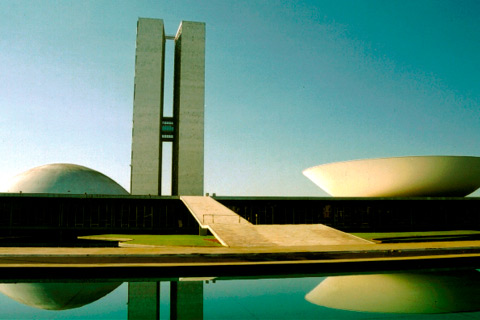 Brasilia and the high modernist city:
Brasilia and the high modernist city:
– Closest example of a high modernist city, having been built more or less along the lines of Le Corbusier’s visions;
- Realization was the pet project of Juscelino Kubitscheck, the populist president from 1956-1961;
- Idea of a new capital in the interior;
- Louis Costa won the architecture competition;
- Conceived of by Kubitschek, and by Costa and Niemeyer as a city of the future, a city of development, a realizable utopia;
- Made no reference to Brazil’s past, habits or traditions;
- It was supposed to transform the lives of those who lived there;
- Whole point was to manifest a contrast to corruption, backwardness and ignorance of the old Brazil;
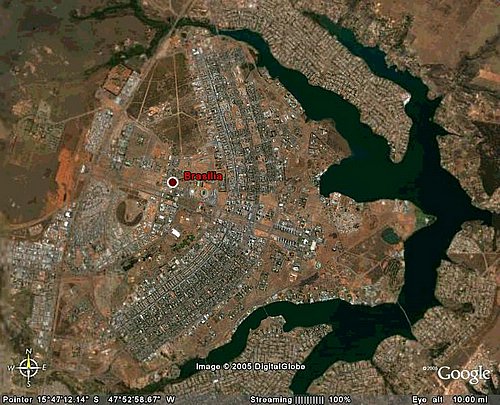 Eliminate public squares and crowded corridors;
Eliminate public squares and crowded corridors;- Lots of open space but dead space;
- Everything planned, no organic;
- development of street corners, cafés etc;
- Failed to go precisely as planned;
- Instead of a classless administrative city, it was a city marked by a stark spatial segregation according to social class, the poor lived on the periphery and commute long distances to the center;
- Not successful in its aim to transform way of life, however did depart from old style cities of Brazil.
[The following is a point-form note series on Local Government Politics aggregated from an academic course on that subject.]
 The City Manager Model:
The City Manager Model:
– Referenced in Urban Governance in Canada by K. Graham, S. Phillips with A. Maslow
- The city manager model is at the other end of the spectrum from the departmental model, fostering greater administrative integration and a more hand-off role of municipal council.
- It arrived in Canada as early as the 1900s as one of the prescriptions from the municipal reformers, they thought it would create more professionalism in city government and permit council to serve more as a corporate board of directors than as managers of the city’s affairs. Councils opting for this approach hire a professional manager to oversee all administrative activities and all departments of city hall.
- All department heads report to the manager
- Slow to take hold in Canada
- Conflict between the mayor and the city manager
- Examples today, Halifax, Edmonton, and Vancouver
- US to limit corruption, an objective a-political person would be in control
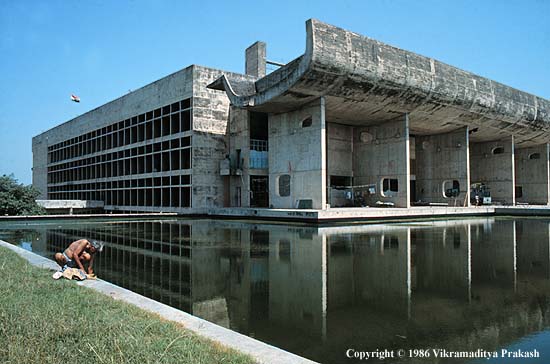 Urban populism as a legacy of historical development in Canada (360):
Urban populism as a legacy of historical development in Canada (360):
– Referenced in Urban Governance in Canada by K. Graham, S. Phillips and A. Maslow
- It has been suggested that the period between Confederation and the rise of the managerial reform movement in the 1890s represents an early epoch of vital local democracy, despite lack of voting for women and other minorities
- Although property restrictions still narrowed the electorate clear lines of responsibility existed to inhabitants
- End of Golden age, when Provincial governments usurped local authority
- Important developments in urban populism between the early part of the century and the contemporary period are rooted in participation outside the traditional definitions of municipal electoral politics, for example:
- 1919 Winnipeg General Strike was primarily about broader issues of labor rights, social justice and economic well-being. Nonetheless it shaped electoral politics in the city of Winnipeg.
- Oshawa General Strike, it cast a shadow over the practice of urban politics in other Canadian cities as well. Example, business leaders and municipal politicians in Toronto worried throughout the Depression about the emergence of unions as an active force in municipal politics.
- The effects of the urban managerial reform movement stifled the rise of urban populism in the period from the early twentieth century to the end of WWII. The establishment of numerous agencies, boards, commissions to oversee key local functions was an important factor, in some cases these special districts were less accountable and responsive to general public because they were captured by special interests. Example:
- City of Vancouver’s town planning commission was established in 1925, in response to Vancouver Board of Trade, The Association of Property Owners and other real estate interests. All proposals went through the Association of Property Owners before sending them to the public domain
- Not until the post WWII period did major changes take place, resulting in urban representation and politics as we now know them.
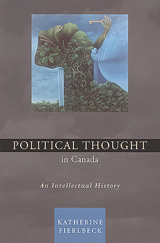 The legacy of Canadian intellectual history:
The legacy of Canadian intellectual history:
– Referenced in Urban Governance in Canada by K. Graham, S. Phillips and A. Maslow
- There have been a number of central themes in the conceptualization of Canadian cities and their governments embedded in it.
- These themes concern the origins debates abut the roots of local and urban government in Canada, specifically the influence of British tradition and government and the urban heritage of Canada’s “great and generous American neighbor
- They also concern debates about the role of cities and city governments in generating economic prosperity and originating other forward impulses.
- Origins Debate (2 elements):
- Requirement of an essentially colonial administration to have some form of direct administration over the pre-confederation colonies, it pre-dates notions of local democracy, whereby local governments would have had independent elections. Rooted in early military regimes of French and English Colonialism. British began in the same way surveying for townships along the St. Lawrence River in 1783. However, did not call them townships, but numbered them, related to US conflict
- Emergence of municipal institutions with the additional elements of democratic self-rule, independent elections, and revenues. Attributed to two developments. The arrival of settlers from New England, and the fruition of the English reform movement through the passage of the Reform Act in 1832 and the first modern piece of legislation affecting English local government in 1835
- Also, development of local, municipal governments slowed because of anti-democratic views of elite family compacts, and the requisites of the colonial administration and protection from American intrusion of the evolution of our government system
- American influence encouraged rebellions of upper and Lower Canada and the drive for responsible government in Nova Scotia.
- 1849 Baldwin Act in Ontario, which has had a seminal influence on the development of local government till today, it was first piece of legislation that created a uniformed system of municipal government over an entire province, it created a two tier system (335)
- See 335, 336
- Durham Report?

